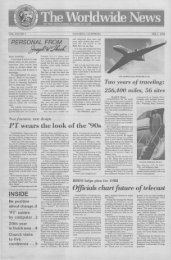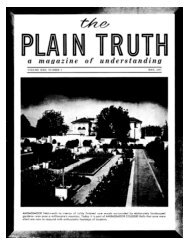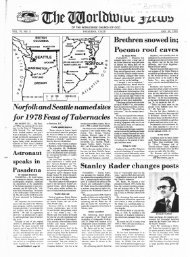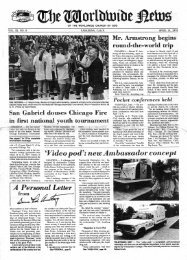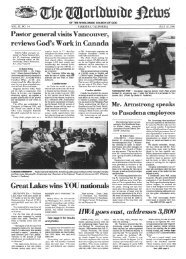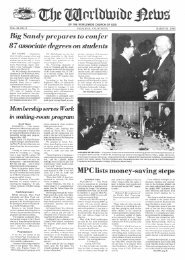PT Sep-78 - Herbert W. Armstrong Library and Archives
PT Sep-78 - Herbert W. Armstrong Library and Archives
PT Sep-78 - Herbert W. Armstrong Library and Archives
Create successful ePaper yourself
Turn your PDF publications into a flip-book with our unique Google optimized e-Paper software.
A California-based nonprofit research institute has<br />
come up with a practical <strong>and</strong> commonsense approach<br />
to the energy crisis which completely short -circuits, the.<br />
traditional methods requiring high technology <strong>and</strong><br />
massive capital investment. Involved was the<br />
transformation of a dilapidated frame building into<br />
an energy-saving <strong>and</strong> resource-efficient environment.<br />
Informed peopJe now agree that the average family's house <strong>and</strong> lifestyle,<br />
especially in the more urbanized <strong>and</strong> industrialized nations, will<br />
have to undergo fundamental changes towards being more environmentally<br />
sound based on reduced energy <strong>and</strong> resource consumption.<br />
But how should this be done? Where is there a model, a totally integrated<br />
example of energy- <strong>and</strong> resource-efficient living in a typical house? Suppose<br />
an average urban family of four, motivated to change their lives, but forced<br />
to live within the normal urban constraints of limited time, space, <strong>and</strong> light,<br />
asked: How can we achieve environmentally sound living? Can you show us<br />
a "different" rather than a "lower" st<strong>and</strong>ard of living?<br />
An answer is now available: The Integral Urban House, 1516 Fifth St,<br />
Berkeley, California 94710. In 1974 a California-based environmental organiza~ion<br />
, the Farallones Institute, decided to commit its resources to develop<br />
a practical working model of such a house <strong>and</strong> life-style. They bought <strong>and</strong><br />
retrofitted an aging Victorian on a 6,OOO-square-foot lot By thoroughly<br />
redesigning the house <strong>and</strong> grounds they aimed to illustrate exactly · what a<br />
motivated urban family could<br />
accomplish. By 19<strong>78</strong> they had<br />
completed the prototype, which<br />
is open to the public. "A family<br />
in this house creates only 10-35<br />
percent of the environmental<br />
impact of a family in a typical<br />
American house," said Tom Javits,<br />
director of the house.<br />
What makes the family living<br />
in this house different? In brief,<br />
they:<br />
• Raise all their owri vegetables,<br />
most of their own fruit,<br />
plus honey.<br />
• Produce their own meat<br />
from chickens, eggs from chickens,<br />
<strong>and</strong> fish from a fishpond.<br />
• Recycle all vegetable, animal<br />
<strong>and</strong> human wastes, calling<br />
the materials "resources."<br />
• Use solar energy to heat their space, water, <strong>and</strong> food.<br />
• Use wind energy to aerate their food-fish pond.<br />
• Control all insect pests with physical <strong>and</strong> biological controls rather than<br />
with poisons.<br />
• Reuse household water, which is recycled to the garden through a "gray<br />
water" system.<br />
• Generally make the best possible. use of the resources available.<br />
To learn how all this worked, I watched Tom Javits <strong>and</strong> three other house<br />
residents. do their weekend chores. "Remember that when all the<br />
systems of the house are set up," said Javits, "they can be maintained in<br />
about eight hours of work per week, or two hours per person. The house<br />
ABETTER<br />
ENERGY-SAVING<br />
IDEA<br />
THE<br />
INTEGRAL<br />
URBAN<br />
HOME<br />
16







